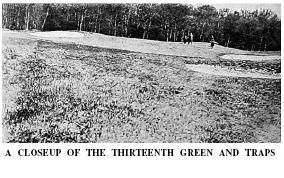The architectural history of Chantilly, as I understood it, was:
- originally designed by JH Taylor, opened in 1909
- held Open de France 1913, won by Duncan
- damaged in WW1
- early 1920s Simpson redesigned championship course + added new 18
- damaged in WW2, with 9 holes from Simpson (new) course lost
But recently in searching for Mackenzie I stumbled across an article in Le Figaro newspaper of 24 December 1911. Here it is in the original French:
Le Golf de Chantilly vient d'avoir la visite
de M. Colt de Sunningdale, l'architecte de
golf bien connu qui est venu se rendre
compte des travaux exécutés depuis l'année
dernière sous ses inspirations.
M. Colt a adressé ses félicitations au co-
mité sur la façon dont ces travaux avaient
été conduits et sur l'ètat actuel du terrain
il a, en outre, donné de nouvelles et précieuses
indications.
Les trous numéros 13 et 16 entre autres se-
ront entièrement modifiés et les nombreux
habitués de Chantilly auront d'ici peu de
nouvelles et agréables surprises.
My French is the sort that invariably gives me the calf's liver in a restaurant, no matter what I thought I ordered. So, with a little help from a machine translation, here is the English version (I think):
The Chantilly Golf Club has just been visited by Mr. Colt of Sunningdale, the well-known golf architect. He came to assess the work carried out since last year under his suggestions(?).
Mr. Colt congratulated the committee on the way in which this work had been carried out and on the actual result in the ground. Moreover, he gave new and invaluable suggestions.
The 13th and 16th holes among other things will be entirely modified and the many familiar with Chantilly will get a little bit of news and pleasant surprises.
I have not been able to find another reference to Colt, nor a meaningful article on Chantilly, in any of the Paris dailies going back to the opening of the club. Very likely however, the problem is lack of accessibility to these archives. Electronic searches / OCR technologies do not work very well. On the other hand, that major tournaments received a bare paragraph or two may indicate a Gallic disinterest in the sport.
So, here is my revised best understanding of the early architectural history of Chantilly:
- originally designed by JH Taylor, opened in 1909
- modified by Colt from 1910-1912
- held Open de France 1913, still won by Duncan
- damaged in WW1
- 1919-1920 reconstructed: greens rebuilt, bunkers added, course *shortened* and rerouted (first six holes converted into the last six holes). Presumably this work was done by Simpson but he is not mentioned in the July 1921 Golf Illustrated, which is the source for this information
- early 1920s? Simpson added new 18
- damaged in WW2, with 9 holes from Simpson (new) course lost
Not so fast: a July 1924 Golf Illustrated article by J. Galbreath Horn states that work was done on the course in 1912...by Thomas Simpson. Specifically, the course was "remodeled, with more scientific greens."
Hawtree makes no mention of Colt's involvement at Chantilly, nor does Simpson in his book (surprise). The Architects of Golf similarly have no Colt attribution.
So who's right? I have my money on Le Figaro owing to:
- the specificity of the Colt references
- the timing of the article being close to the dates in question, whereas the Horn article is 12 years after
- Colt being in France during the period in question to construct Saint-Cloud (per 10 October 1911 Le Figaro)
- Simpson, from what I have read on this site, did not like Colt, a potential motive to airbrush Colt out of the picture
Given Simpson's opinion of Colt plus WW2 not to mention whatever temptations and fads the club may have succumbed to over the years, it probably is fair to say Colt's work at Chantilly is at best the barest of palimsests.
I did find, serendipitously, pictures of the 13th and 16th greens in those two Golf Illustrated articles -- but by the 1921 piece these are not Colt's work. (The last and first six holes from the old course were reversed.)
Here they are:


I have written the club to see if they can shed any light into this apparently dark corner!
A bientôt,